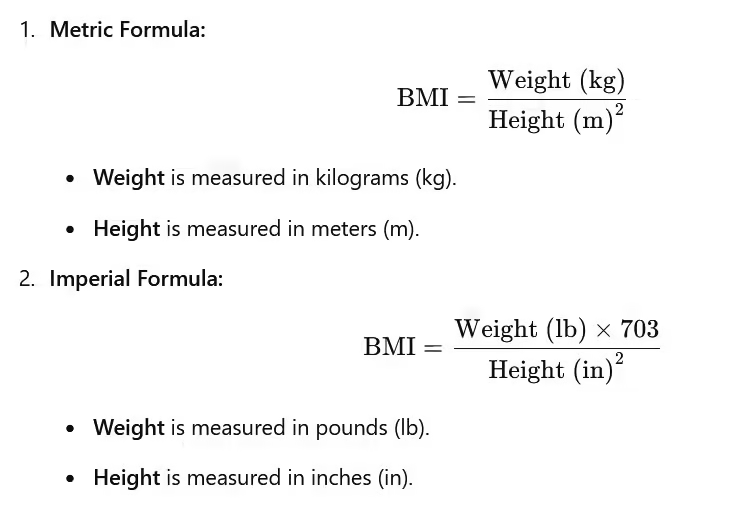Body Mass Index (BMI): Definition, Calculation, and Use
Body Mass Index (BMI) is a numerical value derived from an individual’s weight and height. It is widely used as a simple and quick screening tool to assess whether a person is underweight, normal weight, overweight, or obese. Though it does not directly measure body fat, it provides a reasonable estimate of a person’s body composition and potential health risks related to weight.
How is Body Mass Index Calculated?
BMI is calculated using the following formulas:

BMI Categories and Interpretation
Body Mass Index values are interpreted based on standard categories defined by the World Health Organization (WHO):
| BMI Range (kg/m²) | Category | Health Risk |
|---|---|---|
| Below 18.5 | Underweight | Nutritional deficiencies, low immunity |
| 18.5 – 24.9 | Normal weight | Low risk (healthy range) |
| 25.0 – 29.9 | Overweight | Increased risk of cardiovascular diseases |
| 30.0 – 34.9 | Obesity Class I | High risk of heart disease, diabetes |
| 35.0 – 39.9 | Obesity Class II | Very high risk of serious health conditions |
| 40.0 and above | Obesity Class III (Morbid Obesity) | Extremely high risk of life-threatening diseases |
Uses of Body Mass Index in Health Assessment
- Screening Tool:
Body Mass Index is widely used by healthcare providers as a preliminary tool to screen individuals for potential weight-related health issues, such as heart disease, type 2 diabetes, hypertension, and certain cancers. - Public Health Monitoring:
Governments and public health organizations use Body Mass Index data to monitor population health trends and design programs to address obesity or undernutrition. - Guiding Lifestyle Changes:
Body Mass Index helps individuals and healthcare professionals set goals for weight management by identifying whether they are within a healthy weight range. - Risk Assessment:
A higher Body Mass Index increases the risk of chronic diseases like cardiovascular diseases, type 2 diabetes, stroke, and certain cancers. On the other hand, a very low Body Mass Index is associated with nutritional deficiencies and weakened immunity.
Limitations of Body Mass Index
- Does Not Account for Muscle Mass:
Individuals with high muscle mass (e.g., athletes) may have a high Body Mass Index despite having low body fat. Body Mass Index may misclassify them as overweight or obese. - Does Not Measure Fat Distribution:
Body Mass Index provides a general estimate but does not show where fat is distributed (e.g., abdominal fat vs. hip fat). Central obesity (fat around the abdomen) is more strongly associated with health risks. - Age and Gender Differences:
BMI is not always accurate for specific populations, such as:- Children: For children and adolescents, age- and sex-specific growth charts are used.
- Older Adults: Aging can change body composition (loss of muscle mass), making BMI less accurate.
- Pregnant Women: BMI does not apply to pregnant women as weight gain during pregnancy is normal.
- Ethnic Variations:
Some ethnic groups may have different health risks at the same BMI. For example, Asians tend to have higher health risks at lower BMI values compared to Caucasians.
Alternative Tools for Measuring Health Risks
Since BMI has limitations, other measures are often used alongside it to provide a more comprehensive assessment:
- Waist-to-Hip Ratio (WHR):
Measures the ratio of the waist circumference to the hip circumference to determine fat distribution. - Body Fat Percentage:
Calculated using skinfold calipers, bioelectrical impedance, or DEXA scans to assess body fat directly. - Waist Circumference:
Measures abdominal fat, which is more strongly linked to health risks. - Body Composition Analysis:
Tools like DEXA scans or BIA (Bioelectrical Impedance Analysis) provide a breakdown of fat, muscle, and water in the body.
Conclusion
BMI is a simple, widely used tool to assess whether an individual falls within a healthy weight range. It provides useful insights for health screening, public health monitoring, and weight management. However, BMI has limitations since it does not differentiate between fat and muscle mass, nor does it account for fat distribution or individual differences such as age, gender, and ethnicity. To obtain a more complete picture of health, BMI is often used in combination with other measurements like waist circumference, body fat percentage, and body composition analysis.
BMI Calculator
More blogs: https://sleepingsirens.com

